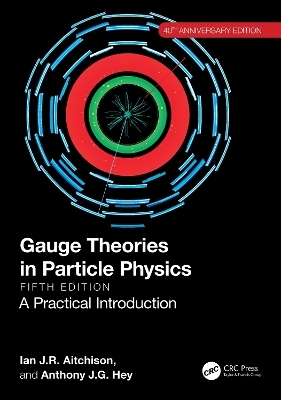
Gauge Theories in Particle Physics 40th Anniversary Edition
CRC Press
978-1-032-49158-5 (ISBN)
The first volume provides a broad and self-contained introduction to the first of these theories, QED. A unique feature is the elementary introduction to quantum field theory, leading in easy stages to covariant perturbation theory and Feynman graphs, thereby establishing a firm foundation for the formal and conceptual framework upon which the subsequent development of the three quantum gauge field theories of the Standard Model is based.
The second volume covers the two non-Abelian gauge theories of QCD and the GSW theory. A distinctive feature is the extended treatment of two crucial theoretical tools: spontaneous symmetry breaking and the renormalization group. The underlying physics of these is elucidated by parallel discussions of examples from condensed matter systems: superfluidity and superconductivity, and critical phenomena. This new edition includes updates to jet algorithms, lattice field theory, CP violation and the CKM matrix, and neutrino physics.
New to the fifth edition:
Tests of the Standard Model in the Higgs and top quark sectors
The naturalness problem and responses to it going beyond the Standard Model
The Standard Model as an effective field theory
This revised and updated anniversary edition provides a self-contained pedagogical treatment of the subject, from relativistic quantum mechanics to the frontiers of the Standard Model. For each theory, the authors discuss the main conceptual points in both mathematical and physical aspects, detail many practical calculations of physical quantities from first principles, and compare these quantitative predictions with experimental results, helping readers improve both their calculation skills and physical insight.
This set should serve as a valuable handbook for students and researchers in advanced particle physics looking for an introduction to the Standard Model of particle physics.
Ian J.R. Aitchison is Emeritus Professor of Physics at the University of Oxford. He has previously held research positions at Brookhaven National Laboratory, Saclay, and the University of Cambridge. He was a visiting professor at the University of Rochester and the University of Washington, and a scientific associate at CERN and SLAC. Dr. Aitchison has published over 90 scientific papers mainly on hadronic physics and quantum field theory. He is the author of two books and joint editor of further two. Anthony J.G. Hey is now Honorary Senior Data Scientist at the UK’s National Laboratory at Harwell. He began his career with a doctorate in particle physics from the University of Oxford. After a career in particle physics that included a professorship at the University of Southampton and research positions at Caltech, MIT and CERN, he moved to Computer Science and founded a parallel computing research group. The group were one of the pioneers of distributed memory message-passing computers and helped establish the ‘MPI’ message passing standard. After leaving Southampton in 2001 he was director of the UK’s ‘eScience’ initiative before becoming a Vice-President in Microsoft Research. He returned to the UK in 2015 as Chief Data Scientist at the U.K.’s Rutherford Appleton Laboratory. He then founded a new ‘Scientific Machine Learning’ group to apply AI technologies to the ‘Big Scientific Data’ generated by the Diamond Synchrotron, the ISIS neutron source, and the Central Laser Facility that are located on the Harwell campus. He is the author of over 100 scientific papers on physics and computing and editor of ‘The Feynman Lectures on Computation’.
VOLUME 1: Chapter 1: The particles and forces of the Standard Model. Chapter 2: Electromagnetism as a Gauge Theory. Chapter 3: Relativistic Quantum Mechanics. Chapter 4: Lorentz Transformations and Discrete Symmetries. Chapter 5: Quantum Field Theory I: the Free Scalar Field. Chapter 6: Quantum Field Theory II: Interacting Scalar Fields. Chapter 7: Quantum Field Theory III. Chapter 8: Elementary processes. Chapter 9: Deep inelastic electron-nucleon scattering. Chapter 10: Loops and Renormalization I: the ABC Theory. Chapter 11: Loops and Renormalization II: QED. Appendix A: Non-relativistic Quantum Mechanics. Appendix B: Natural Units. Appendix C: Maxwell's Equations: Choice of Units. Appendix D: Special Relativity: Invariance and Covariance. Appendix E: Dirac δ-Function. Appendix F: Contour Integration. Appendix G: Green Functions. Appendix H: Elements of Non-relativistic Scattering Theory. Appendix I: The particles and forces of the Standard Model Schrodinger and Heisenberg Pictures. Appendix J: Dirac Algebra and Trace Identities. Appendix K: Example of a Cross Section Calculation. Appendix L: Feynman Rules for Tree Graphs in QED. References.
VOLUME 2: Chapter 12: Global Non-Abelian Symmetries. Chapter 13: Local Non-Abelian (Gauge) Symmetries. Chapter 14: QCD I: Introduction, Tree Graph Predictions, and Jets. Chapter 15: QCD II: Asymptotic Freedom, the Renormalization Group, and Scaling Violations. Chapter 16: Lattice Field Theory, and the Renormalization Group Revisited. Chapter 17: Spontaneously Broken Global Symmetry. Chapter 18: Chiral Symmetry Breaking. Chapter 19: Spontaneously Broken Local Symmetry. Chapter 20: Introduction to the Phenomenology of Weak Interactions. Chapter 21: CP Violation and Oscillation Phenomena. Chapter 22: The Glashow-Salam-Weinberg Gauge Theory of Electroweak Interactions. Chapter 23: Further Developments. Appendix M: Group Theory. Appendix N: Geometrical Aspects of Gauge Fields. Appendix O: Dimensional Regularization. Appendix P: Grassmann Variables. Appendix Q: Feynman Rules for Tree Graphs in QCD and the Electroweak Theory. References.
| Erscheint lt. Verlag | 25.6.2024 |
|---|---|
| Zusatzinfo | 4 Tables, black and white; 12 Line drawings, color; 238 Line drawings, black and white; 12 Illustrations, color; 238 Illustrations, black and white |
| Verlagsort | London |
| Sprache | englisch |
| Maße | 178 x 254 mm |
| Gewicht | 1740 g |
| Themenwelt | Mathematik / Informatik ► Mathematik ► Angewandte Mathematik |
| Naturwissenschaften ► Biologie | |
| Naturwissenschaften ► Physik / Astronomie ► Atom- / Kern- / Molekularphysik | |
| Naturwissenschaften ► Physik / Astronomie ► Festkörperphysik | |
| Naturwissenschaften ► Physik / Astronomie ► Hochenergiephysik / Teilchenphysik | |
| Naturwissenschaften ► Physik / Astronomie ► Quantenphysik | |
| ISBN-10 | 1-032-49158-2 / 1032491582 |
| ISBN-13 | 978-1-032-49158-5 / 9781032491585 |
| Zustand | Neuware |
| Haben Sie eine Frage zum Produkt? |